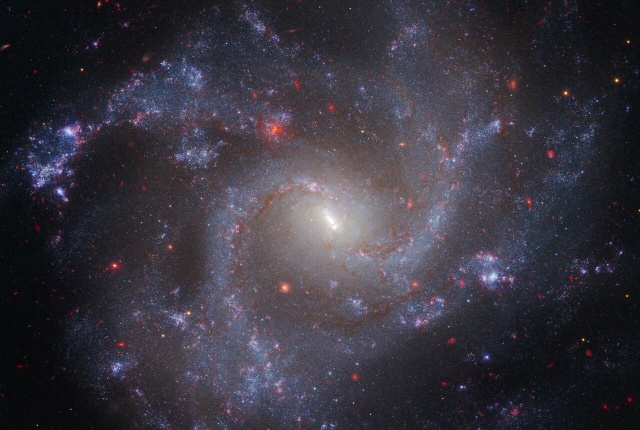Cosmic winds blow from supermassive black holes, "shutting down" galaxies

(Credit: NASA, ESA, CSA, STScI, A. Riess - JHU/STScI)
Supermassive black holes generate cosmic winds that are so strong that they can "shut down" galaxies. This has been confirmed for the first time by an international team of astronomers using the extraordinary capabilities of the new James Webb Space Telescope (JWST).
The results of the study - published in Nature - come from the Blue Jay programme, which involves the first round of JWST observations and is led by Sirio Belli, professor at the "Augusto Righi" Department of Physics and Astronomy at the University of Bologna.
"Thanks to the James Webb Space Telescope, we have finally been able to measure a galactic wind strong enough to shut down a galaxy," explains Professor Belli. "The difference between our study and previous work lies in the type of gas observed: until now it was only possible to measure ionised and therefore warm gas, while with the Webb telescope, we can now also measure neutral gas, which is cold."
The academics' research focused on a still little understood phenomenon known as "quenching": the process that suppresses the ability to form new stars during the evolution of massive galaxies. In the early universe, galaxies transformed large amounts of gas into stars and were therefore able to grow very rapidly. At some point however, the largest galaxies suddenly stopped growing.
One hypothesis put forward by scientists to explain this phenomenon is that this quenching is due to the supermassive black hole at the centre of every galaxy. In fact, theoretical models show that these enormous black holes can generate winds so strong that they can sweep away all the gas, preventing new stars from forming. The problem, however, is that observations to date have only detected weak galactic winds, insufficient to trigger the quenching mechanism. The scientists' hope was that the advanced capabilities of the new James Webb Space Telescope would provide new information.
Among the first 150 galaxies observed by the Blue Jay programme, astronomers focused on COSMOS-11142: a galaxy more than ten billion light years away.
"Thanks to the observations using the James Webb Telescope, we have been able to take a picture of this galaxy as it appeared in the early universe," says Sirio Belli. "At that time, which is often referred to as the Cosmic Noon, the galaxies were at the peak of their ability to form new stars, and it was at that time that the quenching process began."
Thanks to the capabilities of the JWST, the scientists have discovered that more than 90% of the galactic wind generated by the supermassive black hole at the centre of the galaxy is made up of neutral gas: a type of cold gas that was previously almost invisible to telescopes.
"The galaxy we observed is in the phase after its maximum growth, when the ability to form new stars is rapidly diminishing," confirms Belli. "By analysing the galactic winds, we were able to confirm that the strong outflow of neutral gas is the most likely factor causing the quenching phase in massive galaxies."
The study was published in Nature under the title 'Star Formation Shut Down by Multiphase Gas Outflow in a Galaxy at a redshift of 2.45.' Participating for the University of Bologna were Sirio Belli and Letizia Bugiani from the 'Augusto Righi' Department of Physics and Astronomy.






